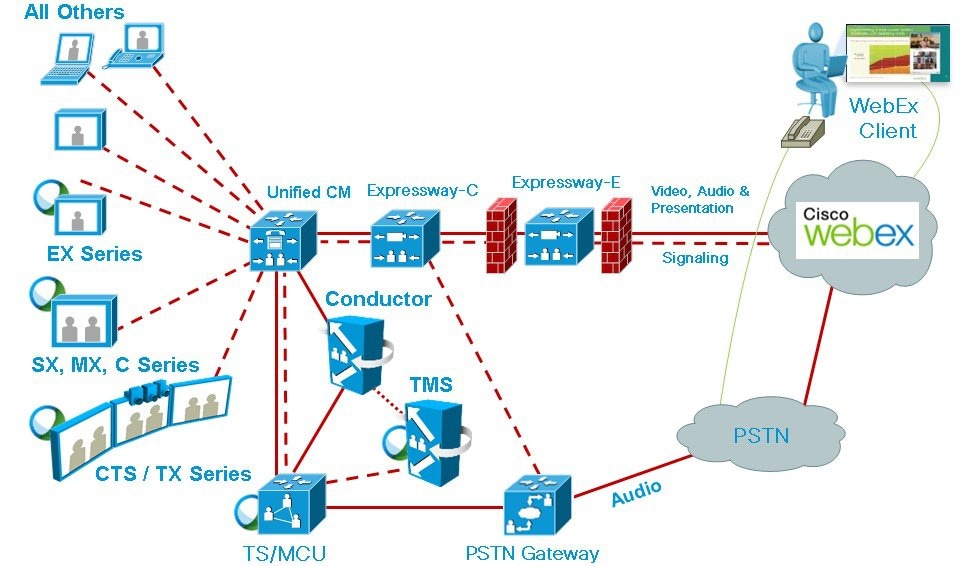- About CMR Hybrid
- Planning
- Deployment Options
- Requirements
- Set Up the Solution Components
- Connect Cisco TelePresence Conductor to Call Control
- Configure Bridge Scheduling
- Configure Cisco MCU and TelePresence Server
- Configure Call Control
- Configure Certificates on Cisco Expressway-E and Cisco VCS Expressway
- Configure Cisco TelePresence Management Suite
- Configure Cisco TelePresence Management Suite Extension for Microsoft Exchange
- Configure TelePresence Management Suite Provisioning Extension
- Configure Audio
- Integrate Cisco TelePresence with a Cisco WebEx Site Administration Account
- Manage CMR Hybrid Meetings
- Troubleshoot CMR Hybrid
- Add Cisco Unified Communications Manager Normalization Scripts
- Migration Paths
- Set Up Cascading for Large-Scale or Critical Meetings
- Index
Cisco Collaboration Meeting Rooms (CMR) Hybrid Configuration Guide (TMS 15.0 - WebEx Meeting Center WBS30)
Bias-Free Language
The documentation set for this product strives to use bias-free language. For the purposes of this documentation set, bias-free is defined as language that does not imply discrimination based on age, disability, gender, racial identity, ethnic identity, sexual orientation, socioeconomic status, and intersectionality. Exceptions may be present in the documentation due to language that is hardcoded in the user interfaces of the product software, language used based on RFP documentation, or language that is used by a referenced third-party product. Learn more about how Cisco is using Inclusive Language.
- Updated:
- May 12, 2016
Chapter: Deployment Options
Deployment Options
SIP Video, Presentation, and Audio in a Unified CM-centric Deployment
WebEx is deployed using WebEx Audio. Main video, content, and audio to and from the WebEx cloud is negotiated between the Cisco Expressway-E on the customer site and the WebEx Cloud. All media (main video, content, and audio) flows over IP negotiated using SIP. Blue and green balls symbolize WebEx-enabled endpoints (ball displayed on endpoint display) (OBTP).

SIP Video, Presentation, and PSTN Audio in a Unified CM-centric Deployment
WebEx is deployed using WebEx Audio using PSTN. Only main video and content is negotiated through the Cisco Expressway-E on the customer site and WebEx cloud (SIP/IP).
At the time of scheduling, Cisco TMS provides the MCU PSTN access information (Dial number, Conference ID, Attendee ID). The Cisco MCU calls out and sets up the audio-only call over PSTN to the WebEx cloud, passing the conference ID and attendee ID using DTMF.
This deployment can be set up either of the following ways:
 Note | Customers using a Codian ISDN Gateway must register it to Cisco VCS Control and therefore must use Cisco VCS. |


SIP Video, Presentation, and Audio in a VCS-centric Deployment
WebEx is deployed using WebEx Audio. Main video, content, and audio to and from the WebEx cloud is negotiated between the Cisco VCS Expressway on the customer site and the WebEx Cloud. All media (main video, content, and audio) flows over IP negotiated using SIP. Blue and green balls symbolize WebEx-enabled endpoints (ball displayed on endpoint display) (OBTP).

SIP Video, Presentation, and PSTN Audio in a VCS-centric Deployment
WebEx is deployed using WebEx Audio using PSTN. Only main video and content is negotiated through the Cisco VCS Expressway on the customer site and WebEx cloud (SIP/IP).
At the time of scheduling, Cisco TMS provides the MCU PSTN access information (Dial number, Conference ID, Attendee ID). The Cisco MCU calls out and sets up the audio-only call over PSTN to the WebEx cloud, passing the conference ID and attendee ID using DTMF.
This deployment can be set up either of the following ways:
Using a PSTN gateway registered to Unified Communications Manager.
Using a PSTN gateway registered to VCS .
Figure 5. Network Topology - SIP Video and Presentation with PSTN Audio Using Unified Communications Manager 
Figure 6. Network Topology - SIP Video and Presentation with PSTN Audio Using Cisco VCS Control 
 Feedback
Feedback